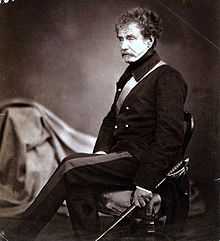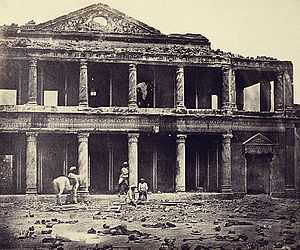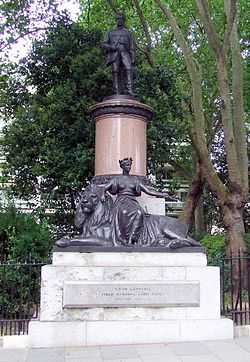Colin Campbell, 1st Baron Clyde
| The Lord Clyde | |
|---|---|
 Lord Clyde in 1855 | |
| Nickname(s) | Sir Crawling Camel |
| Born |
20 October 1792 Glasgow, Scotland |
| Died |
14 August 1863 (aged 70) Chatham, Kent |
| Buried at | Westminster Abbey |
| Allegiance |
|
| Service/branch |
|
| Years of service | 1808 – 1860 |
| Rank | Field Marshal |
| Commands held |
Highland Brigade Commander-in-Chief of India |
| Battles/wars |
Peninsular War War of 1812 First Opium War Second Anglo-Sikh War Crimean War Indian Mutiny |
| Awards |
Knight Grand Cross of the Order of the Bath Knight Commander of the Order of the Star of India |
Field Marshal Colin Campbell, 1st Baron Clyde GCB, KCSI (20 October 1792 – 14 August 1863) was a British Army officer. After serving in the Peninsular War and the War of 1812, he commanded the 98th Regiment of Foot during the First Opium War and then commanded a brigade during the Second Anglo-Sikh War. He went on to command the Highland Brigade at the Battle of Alma and with his "thin red line of Highlanders" he repulsed the Russian attack on Balaclava during the Crimean War. At an early stage of the Indian Mutiny, he became Commander-in-Chief, India and, in that role, he relieved and then evacuated Lucknow and, after attacking and decisively defeating Tatya Tope at the Second Battle of Cawnpore, captured Lucknow again.
Early life
Campbell was born Colin Macliver, the eldest of the four children of John Macliver, a carpenter in Glasgow, and Agnes Macliver (née Campbell).[1] He was educated at the High School of Glasgow and at the Royal Military and Naval Academy at Gosport.[2] In 1807 his uncle, Colonel John Campbell, presented him to the Duke of York, who assumed the boy's surname was Campbell and had him enlisted in the Army under that name: the boy subsequently adopted the name for life.[2]
Military career
Junior officer
Campbell was commissioned as an ensign in the 9th Regiment of Foot on 26 May 1808.[3] He fought under Sir Arthur Wellesley at the Battle of Roliça and at the Battle of Vimeiro in August 1808 during the Peninsular War.[1] He returned to Spain later in 1808 and served under Sir John Moore at the Battle of Corunna in January 1809.[1] Promoted to lieutenant on 15 July 1809,[4] he took part in the disastrous Walcheren Campaign in Autumn 1809 and contracted malaria there.[1]
Campbell returned to Spain again in 1810 and fought at the Battle of Barrosa in March 1811, at the Battle of Vitoria in June 1813 and at the Siege of San Sebastián in July 1813 where he was severely wounded while leading a storming party.[1] Promoted to captain on 3 November 1813, he fought at the Battle of the Bidassoa in October 1813 where he was wounded again.[1] Deployed to Nova Scotia, he served with the 7th Battalion of the 60th (Royal American) Regiment during the War of 1812.[5] He transferred to the 21st Royal North British Fusiliers on 26 November 1818,[6] took part in quelling the slave rebellion in Demerara in August 1823 and secured promotion to major on 26 November 1825.[7]

Commands
Promoted to lieutenant-colonel in an unattached company on 26 October 1832,[8] Campbell became commanding officer of the 9th Regiment of Foot on 8 May 1835[9] but then exchanged to become commanding officer of the 98th Regiment of Foot on 19 June 1835[10] and commanded that regiment at the Battle of Chinkiang in July 1842 during the First Opium War.[1] Promoted to colonel on 23 December 1842, he became garrison commander in Hong Kong at the end of that year.[1] He was appointed an aide-de-camp to the Queen on 23 December 1842[11] and a Companion of the Order of the Bath on 24 December 1842.[12]
Campbell was given command of a brigade of British troops in Lahore in India in 1847.[13] He led his brigade at the Battle of Ramnagar in November 1848, at the Battle of Chillianwala in January 1849 and at the decisive Battle of Gujrat in February 1849 during the Second Anglo-Sikh War.[13] He was advanced to Knight Commander of the Order of the Bath on 5 June 1849.[14] After leading successful expeditions against Pathan tribesmen in the Swat Valley he was rebuked by Lord Dalhousie, Governor-General of India, for being too cautious and resigned his command in India in protest in 1853.[13]
Crimean War
In early 1854, shortly after the Crimean War broke out, Campbell accepted the command of the Highland Brigade.[13] He was promoted to brevet brigadier-general on 21 February 1854[15] and to major-general on 20 June 1854.[16] The Highland Brigade distinguished themselves at the Battle of Alma in September 1854 and, with his "thin red line of Highlanders", Campbell repulsed the Russian attack on Balaclava in October 1854.[13] He was promoted to the local rank of lieutenant general on 23 January 1855[17] and advanced to Knight Grand Cross of the Order of the Bath on 5 July 1855.[18] When the Duke of Cambridge returned to England, Campbell took command of the 1st Division (Guards and Highland brigades) and commanded the Division at the Battle of the Great Redan in September 1855.[13] Promoted to the local rank of full general on 28 December 1855[19] and the substantive rank of lieutenant general on 4 June 1856,[20] he remained in the Crimea hoping to command a corps and, when this opportunity failed to arise, he returned to England.[13] He commanded South East District from July to September 1856.[21] For his services in the Crimean War, he was awarded the Grand Cross of the Sardinian Order of Saints Maurice and Lazarus on 11 August 1856[22] and the Turkish Order of the Medjidie, 1st Class, on 2 March 1858.[23] The Board of Directors of the East India Company also granted Campbell an annuity of £2,000 per annum for life on 9 June 1858.[24]
Commander-in-Chief of India


On 11 July 1857, at an early stage in the Indian Mutiny, Lord Palmerston offered Campbell the command of all British forces in India.[21] Promoted to the local rank of full general in India the same day,[25] he left England the next day and reached Calcutta in August 1857.[2] He relieved and then evacuated Lucknow in November 1857 and, after attacking and decisively defeating Tantia Tope at the Second Battle of Cawnpore in December 1857, he captured Lucknow again in March 1858.[21] He was promoted to the substantive rank of full general on 14 May 1858[26] and raised to the peerage as Baron Clyde, of Clydesdale in Scotland on 3 August 1858.[27] In Autumn 1858, faced with a further mutiny by the East India Company's European troops, who had not received their enlistment bounties, he used British troops to enforce discipline until the British Cabinet agreed some concessions.[21] He continued in charge of the operations in India until all aspects of the revolt had died away and then returned to England in June 1860.[2]
Campbell also served as honorary colonel of the 67th Regiment of Foot[28] and later of the 93rd Regiment of Foot.[29] In retirement he lived at 10 Berkeley Square in London.[30] Promoted to field marshal on 9 November 1862,[31] he died at Chatham on 14 August 1863 was buried in Westminster Abbey.[21]
A statue of Campbell by Carlo Marochetti was erected in Waterloo Place in London in 1867[32] and a statue of Campbell by John Foley was erected in George Square in Glasgow in 1868.[33]
Author of the book Narrative of the Indian Revolt from Its Outbreak to the Capture of Lucknow. published by George Vickers, in 1858.
Family
Colin Campbell married late on in his life and had one child - a daughter (Evelyn Campbell).[34]
References
- ↑ 1.0 1.1 1.2 1.3 1.4 1.5 1.6 1.7 Heathcote, p. 69
- ↑ 2.0 2.1 2.2 2.3 "Colin Campbell, 1st Baron Clyde". Oxford Dictionary of National Biography. Retrieved 11 January 2014.
- ↑ The London Gazette: no. 16149. p. 754. 28 May 1808. Retrieved 11 January 2014.
- ↑ The London Gazette: no. 16275. p. 1098. 11 July 1809. Retrieved 11 January 2014.
- ↑ Marjie Bloy, Ph.D. "The Victorian Web: Sir Colin Cambell, 1792-1863". Retrieved 11 January 2014.
- ↑ The London Gazette: no. 17430. p. 2226. 12 December 1818. Retrieved 11 January 2014.
- ↑ The London Gazette: no. 18197. p. 2165. 26 November 1825. Retrieved 11 January 2014.
- ↑ The London Gazette: no. 18988. p. 2370. 26 October 1832. Retrieved 11 January 2014.
- ↑ The London Gazette: no. 19268. p. 901. 8 May 1835. Retrieved 11 January 2014.
- ↑ The London Gazette: no. 19281. p. 1171. 19 June 1835. Retrieved 11 January 2014.
- ↑ The London Gazette: no. 20180. p. 3821. 23 December 1842. Retrieved 11 January 2014.
- ↑ The London Gazette: no. 20181. p. 3863. 27 December 1842. Retrieved 11 January 2014.
- ↑ 13.0 13.1 13.2 13.3 13.4 13.5 13.6 Heathcote, p. 70
- ↑ The London Gazette: no. 20985. p. 1863. 7 June 1849. Retrieved 11 January 2014.
- ↑ The London Gazette: no. 21524. p. 515. 21 February 1854. Retrieved 11 January 2014.
- ↑ The London Gazette: no. 21564. p. 1933. 22 June 1854. Retrieved 11 January 2014.
- ↑ The London Gazette: no. 21653. p. 251. 23 January 1855. Retrieved 11 January 2014.
- ↑ The London Gazette: no. 21743. p. 2654. 10 July 1855. Retrieved 11 January 2014.
- ↑ The London Gazette: no. 21832. p. 4867. 28 December 1855. Retrieved 11 January 2014.
- ↑ The London Gazette: no. 21899. p. 2378. 8 July 1856. Retrieved 11 January 2014.
- ↑ 21.0 21.1 21.2 21.3 21.4 Heathcote, p. 71
- ↑ The London Gazette: no. 21912. p. 2781. 12 August 1856. Retrieved 11 January 2014.
- ↑ The London Gazette: no. 22107. p. 1251. 2 March 1858. Retrieved 11 January 2014.
- ↑ The London Gazette: no. 22152. p. 2898. 11 June 1858. Retrieved 11 January 2014.
- ↑ The London Gazette: no. 22022. p. 2479. 17 July 1857. Retrieved 11 January 2014.
- ↑ The London Gazette: no. 22139. p. 2404. 14 May 1858. Retrieved 11 January 2014.
- ↑ The London Gazette: no. 22171. p. 3667. 6 August 1858. Retrieved 11 January 2014.
- ↑ The London Gazette: no. 21640. p. 4051. 12 December 1854. Retrieved 11 January 2014.
- ↑ The London Gazette: no. 22087. p. 365. 26 January 1858. Retrieved 11 January 2014.
- ↑ Wheatley, p. 165
- ↑ The London Gazette: no. 22679. p. 5343. 10 November 1862. Retrieved 11 January 2014.
- ↑ "Colin Campbell, 1st Baron Clyde". Flickr. Retrieved 11 January 2014.
- ↑ "Your guide to the statues of George Square". Herald Scotland. 13 September 2012. Retrieved 11 January 2014.
- ↑ family tree
Sources
- Heathcote, Tony (1999). The British Field Marshals, 1736–1997: A Biographical Dictionary. Barnsley: Leo Cooper. ISBN 0-85052-696-5.
- Wheatley, Henry (2011). London Past and Present: Its History, Associations, and Traditions. Cambridge University Press. ISBN 978-1108028080.
Further reading
- Campbell, Colin, 1st Baron Clyde (1858). Narrative of the Indian Revolt from Its Outbreak to the Capture of Lucknow. George Vickers.
External links
| Wikimedia Commons has media related to Colin Campbell, 1st Baron Clyde. |
| Military offices | ||
|---|---|---|
| Preceded by Sir Patrick Grant |
Commander-in-Chief, India 1857–1861 |
Succeeded by The Lord Strathnairn |
| Peerage of the United Kingdom | ||
| New creation | Baron Clyde 1858–1863 |
Extinct |
|
Copy with Malcolm Books of Thetford on ABEbooks website, & also in the British Library.